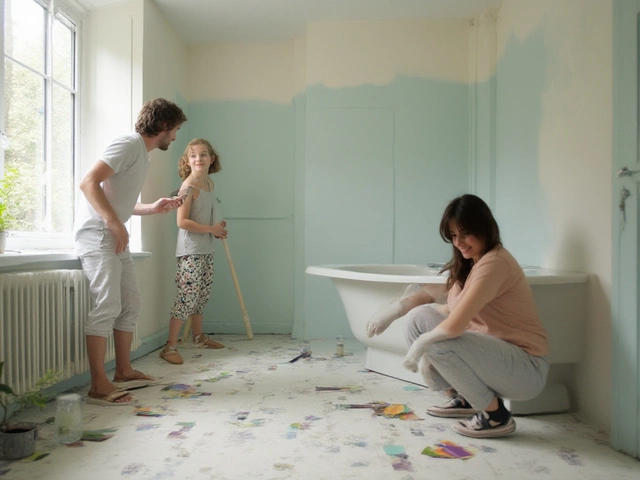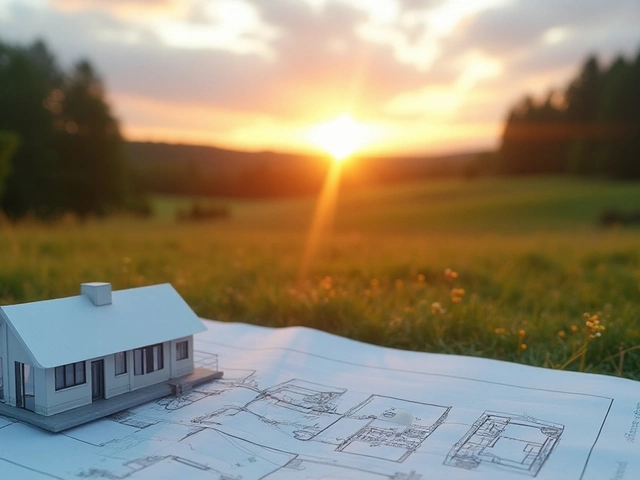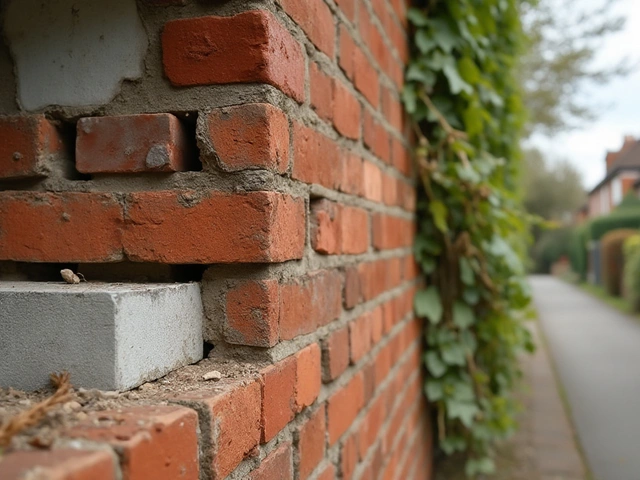Ever walked into a brand new house and noticed a musty smell? Not exactly the open house vibe you want, right? Even the freshest builds can fall victim to hidden mold, and yeah—it can actually make you sick. Builders are in a rush these days, and sometimes moisture gets trapped in walls or under floors before anyone moves in. Mold loves nothing more than a damp, dark corner, so if there’s a leak or construction ran through a rainy week, you could have a problem on day one.
You don’t have to be super sensitive to feel mold’s effects. Headaches, itchy eyes, weird coughs—these can all hit if you’re living with mold in your walls. And it doesn’t always look dramatic like the horror stories online. Any wet patch or new smell should make your senses perk up, especially when you’re dealing with a place that’s supposed to be spotless and move-in ready. If you’re checking out a new place, don’t just admire the fresh paint—look for any water stains, bubbling walls, or windows that gather sweat. These are classic warning signs that mold could be lurking just out of sight.
- Why Mold Is a Problem in New Builds
- The Health Effects: What’s Fact and What’s Drama?
- How Mold Sneaks into Brand New Homes
- Warning Signs When Touring or Moving In
- Smart Prevention and Quick Fixes
- When to Call in the Pros
Why Mold Is a Problem in New Builds
You’d think new builds would be safe from mold, but that’s not always true. One big issue is speed—builders rush to finish homes fast, especially when there’s a lot of demand. Some steps, like letting materials dry out completely, get skipped or shortcut. Add a little rain or leftover construction moisture, and you’ve got a perfect recipe for mold before you even get your keys.
New homes are tightly sealed to save energy, which is great for your bills but not so great for hiding leaks. Less airflow means any trapped water hangs around longer. Drywall, wood, and insulation soak that moisture up like a sponge. If the HVAC system isn’t working yet or there’s no proper dehumidifying, mold can show up in just days.
Building materials aren’t always delivered or stored in dry conditions. Ever see stacks of drywall or lumber sitting at a site after a rainstorm? If those get put right into your house, spores already have a head start. Mold grows quick—under the right conditions (humidity over 60%, some organic food like wood or drywall, and a couple of warm days), colonies can form within 48 hours.
Check this out:
| Risk Factor | Why it Matters in New Builds |
|---|---|
| Trapped Construction Moisture | Materials stay wet inside walls, ceilings, and floors |
| No Ventilation Yet | Fresh paint, flooring glue, and wet lumber need airflow to dry out |
| Tight, Energy-Efficient Shell | Helps moisture stick around where you can’t see it |
| Unfinished Basements or Attics | Often left open to outside weather, collecting water |
What’s this mean for you? A brand new place can secretly have mold and health risks right from the first day. Knowing what to look for and asking about moisture controls before closing makes a huge difference in avoiding all the trouble mold brings.
The Health Effects: What’s Fact and What’s Drama?
There’s a ton of talk these days about getting sick from mold in a new build, but what’s actually true? Here’s the deal: mold in buildings really can mess with your health, but it’s not always as catastrophic as some stories online make it sound. Most healthy adults won’t end up in the hospital if they’re exposed for a short time, but that doesn’t mean you can just ignore it.
The real trouble kicks in if you already have allergies, asthma, or a weaker immune system. For some people, even low levels of mold spores trigger a lot—like sinus trouble, rashes, nonstop sneezing, watery eyes, headaches, or a cough that just won’t quit. The Centers for Disease Control and Prevention (CDC) actually back this up; they’ve linked indoor mold to more asthma attacks and breathing problems, especially in kids.
Some molds produce what experts call mycotoxins. Sounds scary, right? It’s true, certain types can be toxic, but most indoor mold isn’t in that worst-case-scenario league. For healthy people, short-term exposure usually leads to irritation, not serious lung infection. But it's definitely not fun to live with.
- If you start feeling weird symptoms that clear up when you leave the house, that’s a big red flag.
- Anyone in the family with breathing issues should take mold seriously, no matter how new the house is.
- Kids and older adults tend to feel effects faster since their lungs can be more sensitive.
Let’s get concrete for a second. A study published in 2023 found about 21% of new homes inspected had visible mold or water damage, and in those houses, residents reported more coughs and sinus problems than those in dry homes. The takeaway? Living with mold in your new build isn’t going to give you superpowers—it’s more likely to give you a headache, a cough, or just make you feel off your game.
The drama online? Claims that every kind of mold is deadly or that it’s “toxic black mold” 100% of the time. That’s not real. But is regular, boring old household mold annoying and worth fixing ASAP? Absolutely.
How Mold Sneaks into Brand New Homes
So, you’re probably thinking a new home should mean no mold—but it’s not that simple. Mold isn’t picky. All it needs is a little moisture, something to munch on (like drywall or wood), and a bit of warmth. New builds can have all three, especially with today’s tight construction schedules.
Here’s how mold gets a head start in a just-built place:
- Rain during construction: If builders put up framing or drywall while it’s still wet outside—maybe they’re trying to finish fast—it’s easy for water to get trapped inside walls or under floors. That trapped moisture is a breeding ground for mold.
- Improper drying: Sometimes, materials like concrete don’t get enough time to fully dry before the next step begins. Mold spores floating in the air just need a day or two to set up shop if things stay damp.
- Poor ventilation: New homes are sealed up tight for energy efficiency, but that can backfire. If air can’t circulate, humidity rises, making it easier for mold to grow behind walls, in attics, or around windows.
- Plumbing leaks: Even a tiny drip from a pipe hidden inside the wall can soak insulation or wood. You won’t see the leak, but mold sure will.
- HVAC mistakes: Installing the heating and cooling system before the house is dried out can blow moist air through the ducts. This can cause mold to grow in places you’d never check, like the inside of vents.
To see how quickly trouble can start, check this out:
| Material | Time to Mold Growth When Wet |
|---|---|
| Drywall | 24-48 hours |
| Wood framing | 2-3 days |
| Carpet | 24-48 hours |
So even if a home looks perfect at your walkthrough, there could be a mold party starting behind the scenes. If you’re buying new, ask your builder about moisture control, and don’t be shy about asking for proof of proper drying and ventilation during the build. A little curiosity now can save you a headache (literally) later on.

Warning Signs When Touring or Moving In
Shopping for a new build? Keep your eyes (and nose) open for hints of mold—even if the place looks spotless. The truth is, mold doesn't always appear as huge black spots or furry clumps. Sometimes, the danger is way more subtle and tucked out of sight.
Your first clue might be a strange odor. Mold usually gives off a stale, earthy, or musty smell. If you catch a whiff that doesn't fit the "new home" vibe, trust your gut. About half of all people can detect these smells when they enter a room, so don’t brush off even a faint mustiness.
Here are other warning signs to check while you walk through a new build:
- Water stains or discoloration: Look at ceilings, corners, and under windows. Any brownish or yellow marks suggest past water leaks, a common trigger for mold.
- Bubbling or peeling paint: Fresh paint jobs can hide a lot, but if the wall looks bumpy, flaky, or just "off," moisture might be trapped underneath.
- Condensation on windows: Persistent fog or drops on new windows, even on dry days, means there’s extra humidity inside—mold thrives in that.
- Warped floors or baseboards: Wavy floorboards or separated trim usually means there was water, and water plus building materials equals mold risk.
- Strange sensations: If you feel congested, cough, or your eyes itch shortly after entering, your body could be reacting to spores in the indoor air.
For new homes, these issues are more common than you’d expect. According to a recent survey by the National Association of Home Builders, around 20% of new construction owners reported some form of moisture issue within the first year.
| Area | Common Problem | Mold Risk Level |
|---|---|---|
| Basements | Dampness, musty smells | High |
| Bathrooms | Poor ventilation | Medium |
| Window sills | Condensation, discoloration | Medium |
| Attics | Unseen leaks | High |
Before moving in, ask the builder if they did a post-construction moisture check or had a third-party inspector look at the place. Sniff around, peek in corners, and don’t be shy about pointing out anything odd. Catching a mold problem early in your new build saves money and headaches later on.
Smart Prevention and Quick Fixes
Stopping mold from showing up in your new home is way easier than fixing a full-blown problem later, and you don’t need fancy gadgets to do it. The basics? Control humidity. Mold loves to grow if indoor air bumps over 60% humidity. Grab a cheap meter from any hardware store and keep your house under that line, ideally around 40-50%.
If you’re moving into a new build, double-check that bathrooms, kitchens, and laundry rooms have working fans that vent to the outside, not just into the attic. Cracking a window after hot showers seriously helps, too. Don’t skip the little stuff—leaky faucets, sweaty pipes, clogged gutters. These can bring water where you don’t want it. Damp = mold city.
- Fix leaks right away, even the tiny ones.
- Keep air moving using fans or by opening windows regularly.
- Use a dehumidifier in basements or rooms that feel muggy.
- Move furniture a few inches away from walls so air can flow.
- Skip carpet in basements or bathrooms, since it traps moisture.
If you spot a small patch (smaller than a dinner plate), you can usually clean it yourself. Wear gloves, use regular dish soap and water, and dry it out fast. Don’t mix bleach with other cleaners, and don’t bother spraying something on mold and just walking away—the spot has to dry totally.
Here’s a quick look at ways to keep your building safe from indoor air headaches:
| Prevention Step | Why It's Key |
|---|---|
| Dry wet spots within 48 hours | Mold usually starts in about 1-2 days |
| Check attics and basements monthly | Early catches save cash and headaches |
| Use exhaust fans | Clears out steamy, mold-loving air |
| Seal windows and walls | Keeps rain and outside humidity out |
If the spot is bigger than a couple square feet, or you smell that classic "damp basement" odor but can’t find the problem, it’s time to call in a pro. For now, sticking with these steps can usually keep your home—and your lungs—out of trouble.
When to Call in the Pros
Trying to handle a serious mold problem in a new build with some store-bought spray? You’re probably wasting your time—and making things worse. Sometimes, you just have to throw in the towel and call mold remediation experts. But how do you know it’s that time?
If you spot mold patches larger than a couple of square feet, or you find it coming back over and over, there’s likely something big going on behind the walls. The EPA recommends professional help if the moldy area is bigger than about 10 square feet (that’s a patch bigger than a standard bath towel). Hidden mold inside HVAC systems, ducts, or insulation is another big flag. These situations are way beyond regular cleaning—they need special tools and safety gear.
Here are moments you shouldn’t mess around:
- You or family members have health symptoms (like coughing, rashes, or sinus issues) that get worse at home but ease up elsewhere.
- The musty smell never goes away, no matter what you try.
- The mold keeps spreading, even after a good cleaning.
- There’s water damage from leaks, floods, or burst pipes—especially if it wasn’t dried out within 24–48 hours.
- Mold appears in your HVAC system—this can blow spores all over your living space.
Professional remediation teams do more than just clean. They check for hidden leaks, run moisture tests, and use things like HEPA vacuums and industrial dryers. They can also check your indoor air quality to spot those tiny mold spores floating around. Don’t trust your health to a cover-up job—a true fix means finding the source and stopping it for good.
| When to DIY | When to Call Pros |
|---|---|
| Small patch (under 10 sq. ft.) | Large patch (over 10 sq. ft.) |
| Easy to reach & wipe clean | Inside HVAC, walls, or insulation |
| No repeat outbreaks | Mold keeps coming back |
| No health effects noticed | Worsening health symptoms |
If you’re moving into a new build and spot major mold or can’t get answers from the builder, don’t wait. Bring in the pros and get the air tested before you settle in. A quick call could save you months of hassle and help you breathe a lot easier.





